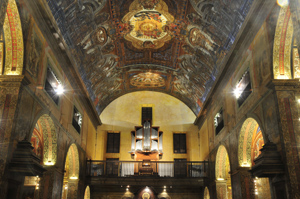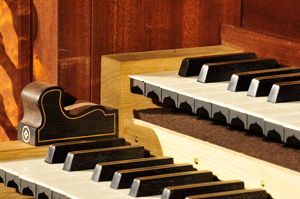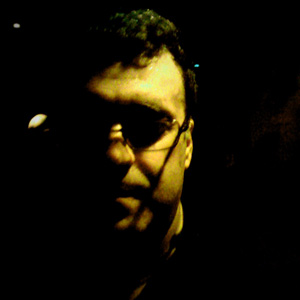 Friday, 26 October, 9.30, p.m.
Friday, 26 October, 9.30, p.m.
Church of São João Evangelista (Colégio)
Roberto Antonello, organ
Maurizio Croci, organ
Nuno Morna, reciter
This concert for four hands (and four feet) is intended for children and for their families, open to a diverse audience, and not only specialists.
The principal work in the programme is the well-known musical fable Peter and the Wolf by Sergei Prokofiev. The work will be given in a version in which the organ, played by four hands, replaces the chamber orchestra envisaged by the composer. Music and text alternate as in the original version. It will be possible to appreciate the “concert” registers of the organ. The string and wind instruments that provide the voices of the various characters of the fable (each character is represented by a specific theme played by a specific instrument) are replaced by corresponding organ registers: the transcription endeavours to preserve the colours of the original instrumentation. This particular arrangement, given for the first time by Roberto Antonello and Maurizio Croci in Fribourg (Switzerland) in 2007, was published by Edizioni Ricordi and recorded on CD by the same performers on the organ of the Church of Notre-Dame de la Dalbade in Toulouse (France) in 2010. The score and the CD have become an educational project for the cities which make up the ECHO association (European Cities of Historic Organs), one of which is Lisbon.
The concert also includes two other works for four hands. The Sonata in D major by Wolfgang Amadeus Mozart, characterized by formal elegance and the beauty of its themes, which transport us to the Viennese atmosphere of the second half of the 18th century. There follows a well-known work by Rossini, the overture to The Thieving Magpie. In this case too the overture implied the orchestra, here replaced by the organ played by four hands. Given for the first time in Milan in 1817, it is based on a French play inspired in an actual event. A girl is unjustly accused of robbery and condemned to death. Her salvation is ensured by a young country boy who discovers in a bell tower the stolen object and the perpetrator of the theft: a bird.
Roberto Antonello
Organ recital four hands
Wolfgang Amadeus Mozart (1756-1791)
Sonata in D major KV 381 (123a)
Allegro
Andante
Allegro molto
Gioachino Rossini
Abertura de La Gazza Ladra
Sergej Prokofiev (1891-1953)
Peter and the Wolf, Op. 67 (1936)
(transcription for organ four hands by Roberto Antonello)
Participants
|
Born in 1967, he graduated in Organ and Organ Composition (with praise), in Choral Music and Choir Conducting, full marks at Bologna University with a final dissertation on Cesar Franck’s Trois Chorals. In 1993, studying with D. Roth, he graduated with Premier Prix d’Excellence at CNM in Issy-les-Moulineaux (Paris). He won national and international Organ Competition prizes from 1987 to 2000, among them the 2nd Interpretation Prize at the XVII International Organ Competition Grand Prix de Chartres 2000 (the only Italian admitted to the final round in the 36 year history of the competition). He has performed in the greatest Festivals and Concert Series in many Italian cities, EU, Switzerland, Croatia, Uruguay, Paraguay, Brazil, and Canada. Active as musicologist, he edited the Vespri di S. Ignacio and Misa a San Ignacio (Ed. Pizzicato) by D. Zipoli and Principia seu Elementa ad bene Pulsandum Organum et Cimbalum (Ed. Missions Prokur - Armelin), coming from the 18th century South American Jesuit missions. As composer, he wrote Via Crucis, multimedial work for historical organ, and the organ duet transcription of peter and the Wolf by prokoviev, published by Ricordi. He has been juror in a number of national and international competitions. In 1994, following success in the national competition for Organ Teachers at the Conservatories, he was appointed, in the same year, titular teacher for Organ and Organ Composition: he is teaching at "Pedrollo" Conservatory in Vicenza, where he is also Head of Organ Studies since 2005and deputy Director since 2010. |
|
Maurizio Croci was born in Varese (Italy). He holds diplomas in organ and harpsichord studies from the conservatoires of music of Milan and Trent (Italy) and spent four years at the Schola Cantorum in Basle (Switzerland) on advanced courses in organ and harpsichord under Jean-Claude Zehnder and Andrea Marcon. He also graduated in musicology at Fribourg University in Switzerland under Prof. Luigi Ferdinando Tagliavini. Prize-Winner of the Paul Hofhaimer international competition in Innsbruck (1998), Mr. Croci has concertized throughout Europe, Russia and Japan, performed J.S. Bach’s complete organ works in Bern to mark the 250th anniversary of the composer’s death and recorded several CDs. In 2011, he recorded Andrea Gabrieli’s organ works on the Marco Fratti organ in the Holy Trinity Basilica in Bern for RSI Rete Due. Maurizio Croci gives Masterclasses on early keyboard music, and sits on the jury of international organ competitions (Alkmaar, Toulouse, Landsberg, Borca di Cadore). He is currently working as Organ Professor at the Haute Ecole de Musique (HEMU) in Lausanne (Switzerland), Harpsichord Professor and Director of the Early Music department of the Milano Civica Scuola di Musica, organist at the Basilica of the Holy Trinity in Bern and of the Collège St-Michel in Fribourg. Maurizio Croci is the artistic director of the Académie d’Orgue de Fribourg and sits on the artistic directors board of ECHO (European Cities of Historical Organs, www.echo-organs.org). |
|
Nuno Morna was born... some time ago, in a very, very distant place, son of an explosive relationship between a woman from Beira and a man from Madeira. He arrived in Madeira in the distant 1970s, full of revolutionary effervescence, which he still misses greatly. He went to University, but he soon discovered that wanted to be as he is. Over the years he has taken part in many cultural activities, from music ro animation, from poetry to humour, but above all he is an actor. The art of acting has taken him to innumerable stages from the North to the South of Portugal, Spain and Brazil. He is currently initiating himself in the art of writing, with a book for children, because he believes that this is where one should begin. |
Notes about the Organ
 Church São João Evangelista (Colégio), Funchal
Church São João Evangelista (Colégio), Funchal
This instrument, with 1586 sounding pipes, is situated in a religious space with certain particularities. As a church typical of those belonging to Jesuit colleges, with a broad nave and quite a gentle acoustic, the organ had to be specially conceived, especially with regard to the measurements of the pipes. Thus all the pipework of the instrument has been specifically tailored to produce a full sound, and each stop produces a timbre with an individual personality, forming part of a harmonic ensemble based more on the sound of fundamentals and less on harmonics. It was also felt to be essential to give the instrument a certain ‘latin’ sonority that would favour performance of ancient music of the Italian, Spanish and Portuguese schools of the 17th and 18th centuries.
Another aspect to be taken into consideration was the need to complement the current range of organs available locally: the new organ responds in an ideal fashion to the performance of works of periods and of technical and artistic requirements that none of the 24 historic instruments of Madeira cater adequately for. It also enhances the range of organs that constitute the island’s heritage by being present in this particular religious space, as well as by existing side by side with other historical instruments. In the decision to build it for this church, not only were the issues of acoustic, aesthetic and liturgical space taken into account, but also the presence there of an important historic instrument which is currently on the list of instruments undergoing restoration.
I Manual - Órgão Principal (C-g’’’)
Flautado aberto de 12 palmos (8’)
Flautado tapado de 12 palmos (8’)
Oitava real (4’)
Tapado de 6 palmos (4’)
Quinzena (2’)
Dezanovena e 22ª
Mistura III
Corneta IV
Trompa de batalha* (bass)
Clarim* (treble)
Fagote* (bass)
Clarineta* (treble)
II Manual - Órgão Positivo (C-g’’’)
Flautado aberto de 12 palmos (8’)
Tapado de 12 palmos (8’)
Flautado aberto de 6 palmos (4’)
Dozena (2 2/3’)
Quinzena (2’)
Dezassetena (1 3/5’)
Dezanovena (1 1/3)
Címbala III
Trompa real (8’)
Pedal (C-f’)
Tapado de 24 palmos (16’)
Bordão de 12 palmos (8’)
Flautado de 6 palmos (4’)
Contrafagote de 24 palmos (16’)
Trompa de 12 palmos (8’)
Acoplamentos
II/I
I/Pedal
II/Pedal
* horizontal reeds
 Roberto Antonello
Roberto Antonello Maurizio Croci
Maurizio Croci Nuno Morna
Nuno Morna